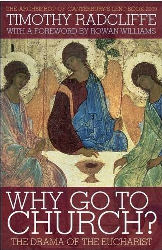
|
Posted December 15, 2008
Book: Why Go To Church?: The Drama of the Eucharist Author: Timothy Radcliffe, OP Continuum. New York. 2008. Pp. 214 An Excerpt from the Jacket:
An Excerpt from the Book: Dom Jeremy Driscoll, an American Benedictine, notes that: . . . monks are always having processions. As a community, whenever we go from one place to another, we don’t just do it helter-skelter; we go in procession. We process into church; we process out. We process to a meal. We process to our cells. We process to the cemetery. We process around our property. I am glad for all this marching about. Of course, it could become too formal; we could make it over-serious, and then it would just be weird. But I experience it as an extra in my life, something in my day that I would not have were I not a monk. And so I am reminded again and again that I am not just vaguely moving through life. In my life I am inserted into the definitive procession of Christ. I am part of a huge story, a huge movement, a definitive exodus. I am going somewhere. All of our processions — in, around and out of church — are signs that we are a pilgrim people, on our way to the kingdom. I particularly like this small procession of people bringing up the giftsw to the altar. It may be just a couple of people wandering up nervously, wondering what they should do, shoving the bread and wine into the nearest hands and dashing back to the safety of their pews, but it is an expression of humanity’s story. In one of my first classes in theology, the novice master drew a big circle on the blackboard, and explained how St. Thomas saw everything as coming from God and returning to God, the exitus and reditus of creation. The whole of creation receives its being from God, and everything seeks its fulfillment in returning to God, which for us humans is a share in God’s own happiness. The procession in which the gifts are brought to the altar makes visible the turning point in that ‘huge movement’ as we swing back toward home. This is the beginning of our journey of hope, our homecoming. The gifts that are brought to the altar come from God and are now on their way back to God. The grain, ‘which earth has given’ has become the bread ‘which human hands have made’, and which is offered to God. A friend, an Anglican Sri Lankan bishop, explained that each week a family takes its turn to bake the bread, the chapatti, that will become Christ’s body. We load the altar with gifts which are from God and for God — not just bread and wine, but our own lives, and that of God’s own Son. We bring up the money which has been collected from the congregation, symbolizing the whole working week which is also offered to God. We recognize that our strength, out talents, our endurance, all that enables us to earn our living, are from God too, and ultimately for God. It is in the workplace too that we struggle to live just and virtuous lives and must discover the consequences of our Christian identity. Ian Stackhouse, a Baptist minister, wrote: ‘When you go to work on a Monday morning, you are not entering deconsecrated ground; rather . . .you are sanctifying even the most mundane routine with Holy Spirit grace.’ He points ut that after David had been anointed, he went straight back to work, shepherding his sheep. When a plane was crashing, someone cried out, ‘For God’s sake, will someone do something religious.’ A Catholic immediately leapt up and took a collection. Table of Contents: Act 1: Faith 1. Homecoming 2. ‘Here I am!’ 3. ‘How can the be?’ 4. Mary rose and went in haste 5. Part 1: We believe in God, the creator of heaven and earth 5. Part 2: We believe in Jesus Christ, the only Son of God, and the Holy Spirit 6. ‘Ask and you shall receive’ Act 2: Hope 1. Preparation of the gifts 2. Death outside the camp 3. ‘The fruitful stones thunder round’ 4. Betrayal into gift Act 3: Love Prologue: Recognizing Jesus 1. Our Father 2. ‘Peace be with you’ 3. ‘Cast the net on the right side of the boat’ 4. “Come and have breakfast’ 5. ‘As the Father has sent me, so I send you’ |
|
